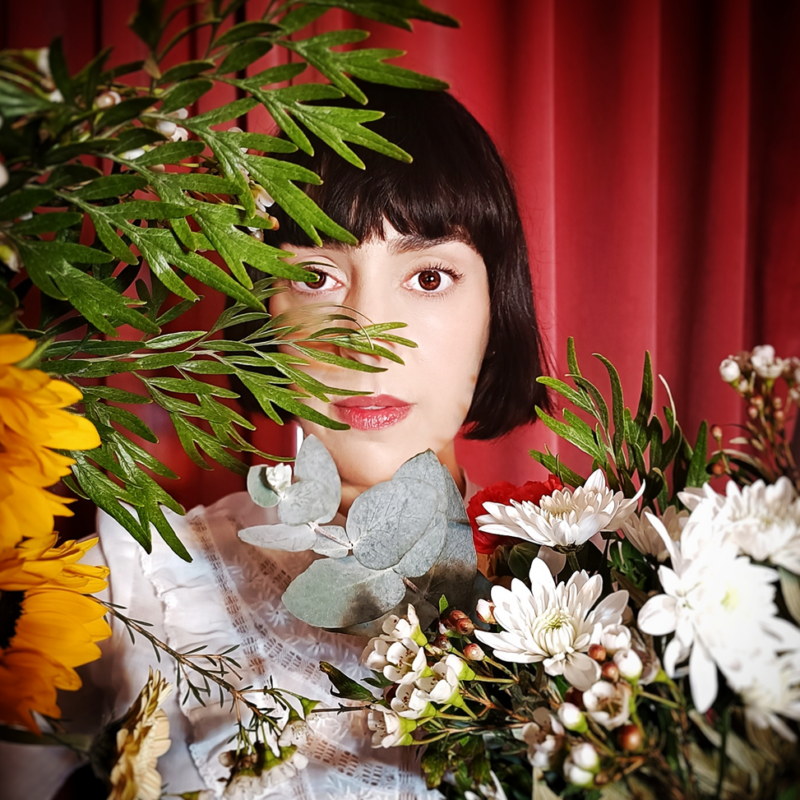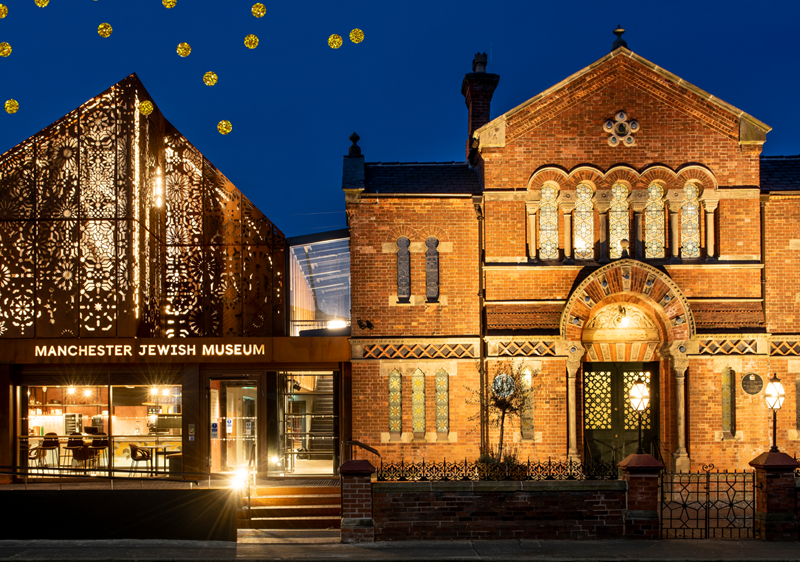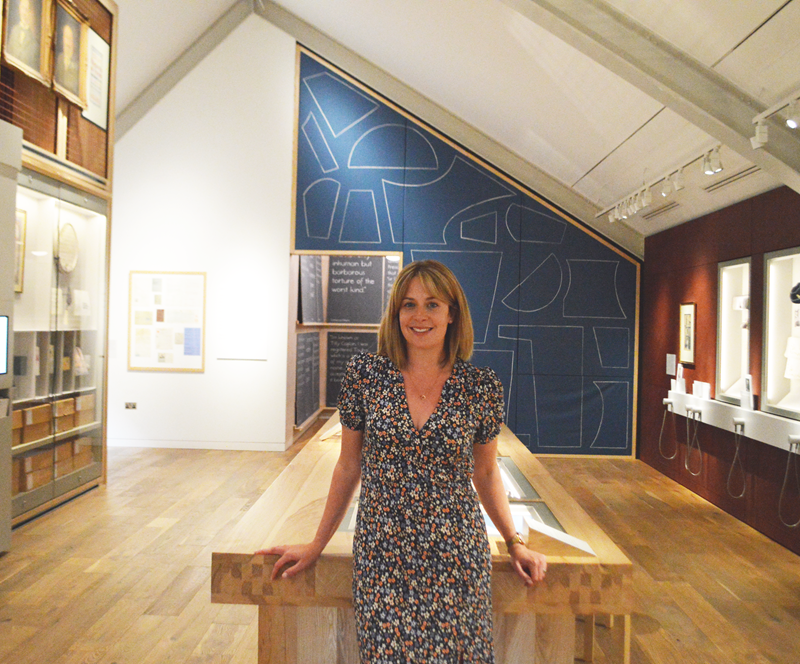“Sara Wesker may have lived 100 years ago but her story is definitely a “Play For Today”.” – Interview with Lottie Walker
On May 1st, International Workers’ Day, Manchester Jewish Museum will host a performance of “Chopped Liver and Unions”, a one-woman play written by J.J. Leppink and performed by Lottie Walker.
The play tells the remarkable but largely forgotten story of Sara Wesker, a trailblazing trade unionist who led the “singing strikers” of 1928, stood on the barricades at Cable Street, and fought tirelessly for East End garment workers. Critically acclaimed and OffFest-nominated, this moving production has already captivated audiences from New York to Edinburgh, and we’re thrilled to bring it to Manchester.
Book tickets for “Chopped Liver and Unions”
Ahead of the show, we spoke to Lottie Walker about the incredible story behind this play.
Hello Lottie! We’re very excited to host “Chopped Liver and Unions” at Manchester Jewish Museum! Before we talk about the play, could you please introduce yourself and tell our audiences a little bit more about your work?
Hello! I’m thrilled to be bringing the show to the Museum – thanks for having us!
I’m the Artistic Director at Blue Fire Theatre Company. We produce and tour small scale shows that focus on unknown and/or under-represented people and forgotten ways of life. We mainly tell true, real life stories but occasionally we’ll dip our toes into a bit of fiction too. This is my second one woman show, written by the wonderful JJ Leppink with musical direction by James Hall, who’s playing for me at the Museum.
I’m so lucky to also have been able to work with our director, Laura Killeen on this piece. Laura is an inspiration! Funnily enough I met Laura when performing my first one woman show at the Rosemary Branch Theatre where she is Artistic Director. “Marie Lloyd Stole My Life” is the story of Nelly Power, the biggest star of Music Hall in her day but now almost totally forgotten. Another strong woman born out of her time! One of our lockdown projects was to record an album of Nelly’s songs – all but one of them had never been recorded before, so we made a bit of history ourselves in 2021. We also have a podcast, “Famous People You’ve Never Heard Of” that does the same thing as the shows but enables us to reach a wider audience and engage with guests who are real experts in their subjects. Very often we’ve found that the forgotten stories are the most interesting.
What first drew you to Sara Wesker’s story, and why did you feel it needed to be told now?
I was invited to sing at the unveiling of the Blue Plaque dedicated to the Matchgirls and there I met Louise Raw, the historian who told me about Sara and said she’d love to get her more recognition. As soon as she uttered the words “Arnold Wesker “ and “singing strikers” I was hooked and saw the potential for a piece of theatre!
To my shame I had no idea of Sir Arnold Wesker’s family background and the fact that Sara was a trade unionist from the East End of London and had a shared history with my parents (my father was a docker in the Royal Docks and on strike a LOT during my childhood) struck so many chords. I had no idea when we started the process that I’d become so emotionally attached to the subject matter – or that the subject matter would be so relevant to today’s world. Sara may have lived 100 years ago but her story is definitely a “Play For Today”.
What excites you most about playing the role of Sara Wesker on stage?
I love her! It’s interesting that for someone who was so well known for her public speaking and organisational skills none of her actual words remain. She really did seem to be written out of history deliberately (perhaps because she upset so many people!). She features a tiny bit in some interviews with and articles about other people involved in the events that Sara was part of, and there are a couple of bad quality photos of her and passing references to her in her nephew’s writings but not much else.
I love the fact that she always stayed true to her principles and never lost faith even when she was badly let down by the organisations and people she’d invested her life in. There’s a sense of such optimism there.
My performance is centred around a quote I read in David Rosenberg’s “Rebel Notes” whilst researching Sara’s life. She was described as “a ferocious speaker, as if the energy of five men was balled up inside that miniature frame of hers.” And yet she was so vulnerable – she suffered a broken heart, betrayal and ill health. But through it all she retained her sense of humour and love of life. She’s a real inspiration. But I think I’d have been pretty scared of her…
“Chopped Liver and Unions” highlights key historical events like the 1928 singing strikes and The Battle of Cable Street. What kind of research or preparation did you do to bring those moments authentically to life?
This bit was relatively easy because my family lived so much of it! The Battle of Cable Street, the proudest moment in East End history was something I was told about from the cradle. I visit the famous mural every time I’m in the area. I was brought up on first hand accounts of the Blitz, and as a small child played on bomb sites in the East End and I’ve lived experience of living hand to mouth when the only breadwinner in the house is either on strike or literally fighting another person to get a day’s work, so it’s no great stretch of imagination for me to step into Sara’s world.
I was also extremely lucky to be given first hand knowledge of Sara and her family in the form of Sir Arnold Wesker’s autobiography and practical help from Dusty, Lady Wesker and her son, the late Daniel Wesker. Lady Wesker called me and told me some lovely family anecdotes that fleshed out Sara’s character a bit and also put her story into context (she was a Ukrainian refugee in the early days of the 20th century). Dan was a true star – he even went as far as trawling the internet for me to find ideas for suitable costumes as the photos of Sara are so scarce and don’t give much detail.
Good timing is a wonderful thing and I was able to visit the “Fashion City” exhibition at the Museum of London last year – it was a history of Jewish tailors and the East End garment industry. The Tailor’s shop reconstruction even had recordings of Mick Mindel and other union leaders for me to listen to.
We tried really hard to locate information about her United Clothing Workers’ Union and wanted to use an image of its banner in the show but sadly – a bit like Sara – it’s been forgotten, absorbed into other, bigger unions along the way and losing its history in the process.
JJ and I also took ourselves on a girls’ day out to do a photo shoot and research areas of London we mention in the play – I had a great full English at Pellicci’s café and we got photos of the original archway to the famous Rothschild buildings – all that now remains of those huge tenements.
I don’t think I’ll ever stop learning about this period of history and the events relating to Sara’s life!
Blue Fire Theatre is known for its unique use of music to enhance storytelling. How does music feature in this production?
It’s one of the reasons the idea for the show first appealed – how wonderful to tell this story using all the original songs sung by the “singing Strikers”. Well that idea was short lived!
We were fortunate to engage with Dr Dan Weinbren from the Open University, who’s written extensively on this subject (and provides the programme note for our show). Dan has copies of the original strike songbooks. These songs were words written by the strikers and put to the popular music of the day, nursery rhymes, hymn tunes, etc..
Where we fell down in using these original songs is that the tunes are not necessarily popular any longer so they wouldn’t resonate with the audience and in most cases they also proved impossible to track down! We were close to abandoning all hope – and the project – when a friend introduced us to “Stand Together”, a songbook of protest songs across the ages that had been published and had a small print run in the 1970’s. We’ve used snippets of songs from this book, along with suffragette songs and one of the original Matchgirls’ protest songs along with a couple from the 1928 books and it all works so much better.
At various points throughout the play our Music Director James Hall inserted tunes that evokes a specific time period and/or emotion. Some people recognise them, others like the effect and all leave the show with an ear worm. I defy anyone not to be humming one of those tunes on the way out – and for some days after the show. Where we couldn’t identify suitable music for our needs for a specific piece of dialogue or action James has composed something for us. He’s a star!
Many of the themes explored in the play, like gender inequality, class struggle, and political resistance, are still relevant today. What conversations do you hope the play will spark in audiences?
We first came at the show with the intention of throwing a bit of light on a forgotten person but the show made its debut in 2023 when there was an incredible amount of industrial action across the world and the synergies with Sara’s struggles were self-evident. In 2024 when we took the show Off-Broadway for a month it was the centenary of the first Labour government – and the Far Right started to make themselves appear more respectable and mainstream. And now, in 2025 as we continue to tour the show we are seeing women’s rights receding in so many parts of the world.
I genuinely think that whenever we do this show there’ll be a mirror image of at least one part of it happening in real time. I always say that the only things in history to change are the names. An important message of the show is that all the things we take for granted now were hard won but can be so easily lost. A sense of entitlement is a dangerous thing. I really hope that audiences – particularly younger people will be inspired by Sara and feel moved to make a difference wherever they can.
What excites you about bringing the play to Manchester and to our 1874 synagogue?
I’m really looking forward to only my second visit to Manchester and especially to visiting the Museum. You can probably tell I love a bit of history! I have already dipped into your online Memory Map more than once. There’s so much to see in the museum that I can only hope I have time to see it all!
It’s funny that once I started on this journey with Sara all sorts of related things happened, including the BBC’s wonderful series of radio dramas “Almonds and Raisins”; The fictitious Sandberg family arrived in Manchester in the same year that the Weskers arrived in London and I’m really looking forward to seeing the area depicted in the book.
As for the synagogue itself – what a beautiful building! I hope (I’m the eternal optimist) that there’ll be time for some quiet reflection in there before I share Sara’s story and I know that your philosophy of “making connections to make things better” means that I’m going to be meeting lots of like-minded people.
I’m so grateful for the opportunity to tell Sara’s story to a new audience and to tell it in a building with such a relevant history.









